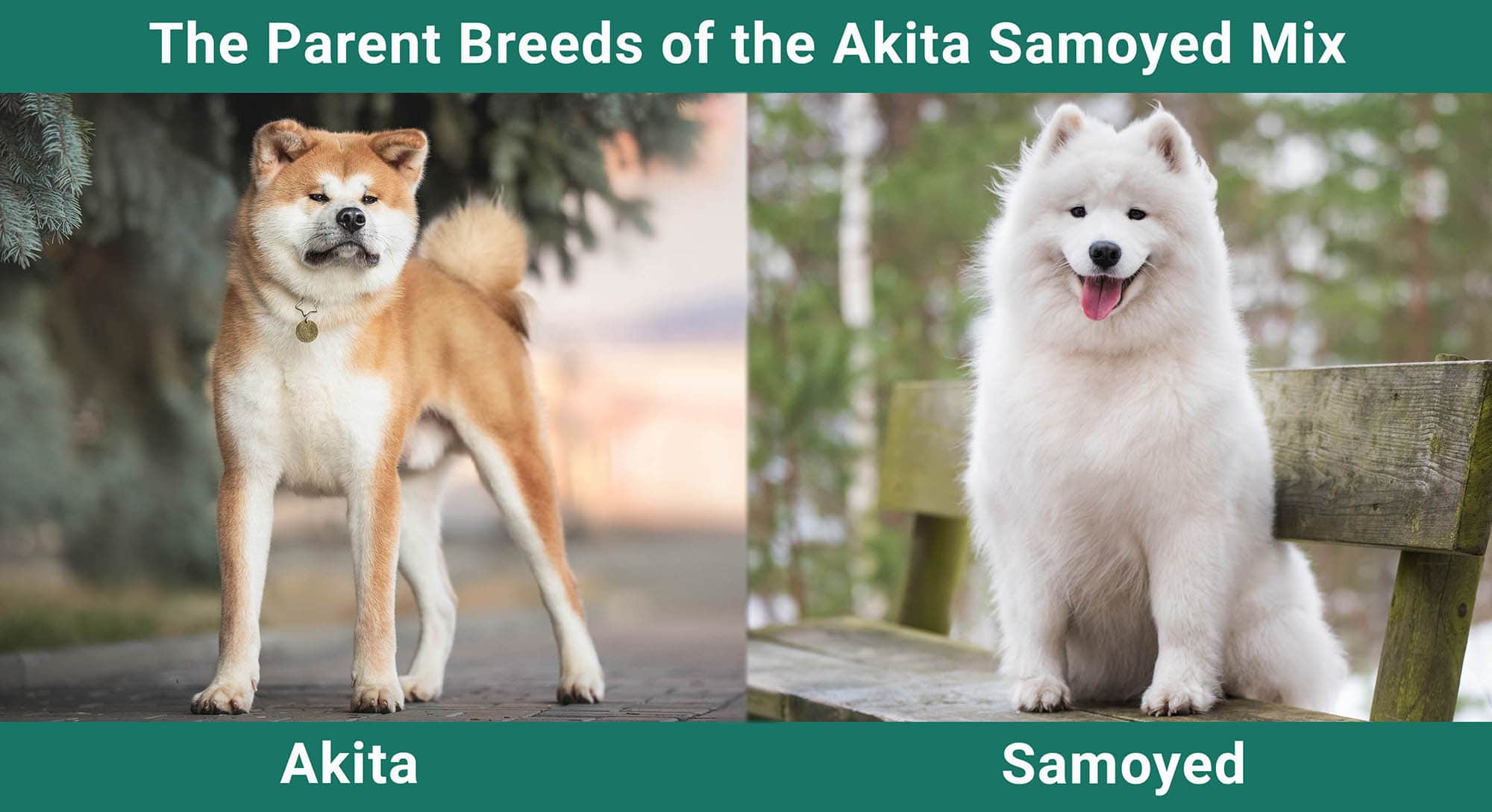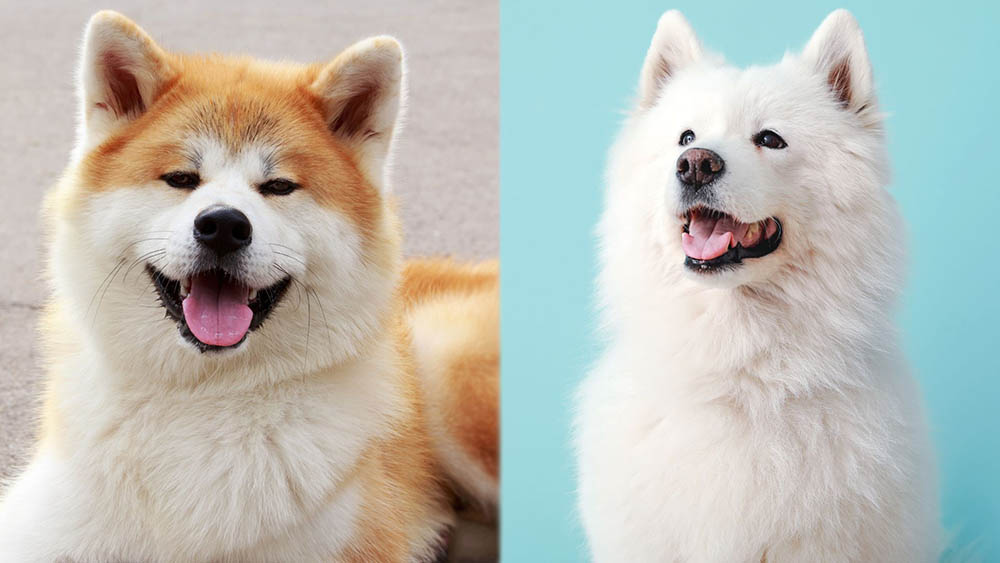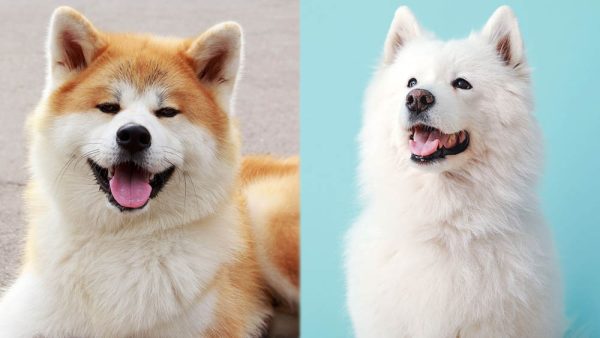Click Below to Skip Ahead
An Akita Samoyed mix, also known as a Samkita, is a mixed breed dog that results from crossing an Akita with a Samoyed. You never really know what you’re going to get with this mixed breed, as they vary considerably. A puppy can inherit any trait from either parent.
Breed Overview
Height:
19–27 inches
Weight:
30–130 pounds
Lifespan:
10–14 years
Colors:
White, black, brown, grey, or a mix of these colors
Suitable for:
Experienced dog owners with plenty of time on their hands
Temperament:
Loyal, brave, intelligent, energetic
When you cross an Akita with a Samoyed, you can expect the resulting puppies to have a mixture of traits from both parents. Their appearance can vary, but they often have a thick coat that requires regular maintenance and grooming. Their size varies considerably, too, depending on the exact traits they inherit.
In terms of temperament, these canines tend to be loyal and at least somewhat protective. They can also be sociable and friendly if socialized properly. However, they tend to be pretty maintenance-heavy dogs, so they’re best for experienced dog owners with plenty of time on their hands.
Akita Samoyed Mix Puppies
Akita Samoyed puppies look and act very similar to other puppies. They’re often very playful and energetic. Therefore, they need lots of playtime and an owner that can pay attention to them for hours a day. They also require a lot of socialization as a puppy, as they can potentially end up with overprotective instincts later on.
Plan on providing these dogs with lots of stimulation starting at an early age.
You likely won’t be able to find these puppies very easily. They are rare. Unlike some other designer dog breeds, the Akita Samoyed isn’t common. Therefore, you’ll probably need to travel and wait for some time before a puppy becomes available.
Because this breed is rare, finding one at an adoption agency isn’t likely. Therefore, you’ll probably have to go through a breeder. It’s important to only purchase from quality breeders, especially given that this breed can have temperament and health issues.

Temperament & Intelligence of the Akita Samoyed Mix
The Akita Samoyed tends to be intelligent, loyal, and protective. They can inherit traits from both parents, though, so it can be hard to predict temperament. They can be challenging dogs and require plenty of socialization and training.
Generally, these dogs have some protective instincts. They’re very alert and can be aloof with strangers but they bond closely with their family. Both of these traits make them good guard dogs. However, it also means that only experienced, prepared owners should consider adopting these canines.
They tend to be rather intelligent and have high problem-solving abilities. They can learn skills with ease. That said, they can be stubborn, too. Therefore, their intelligence doesn’t necessarily mean they are very trainable. They do need lots of mental stimulation, though. Otherwise, they can become bored and destructive.
Are These Dogs Good for Families?
The Akita Samoyed mix can be good for some families. It all depends on what you’re looking for.
On the one hand, these canines are loyal, protective, and affectionate. They get along well with children and are often very patient—even with very young kids. For more active families, they can be energetic playmates. They often have no problems jogging or hiking with their families. They’re also intelligent, allowing them to learn many skills.
On the other hand, they can also be stubborn and overprotective. They need a lot of training and socialization from an early age to ensure they’re manageable companion animals. You also need to provide them with plenty of exercise, which can be an issue for some families. They also aren’t the friendliest dogs with strangers, and they require significant amounts of grooming.
Does This Breed Get Along with Other Pets?
Not really. This breed tends to be dominating towards other dogs, especially those of the same gender. Therefore, they aren’t often the best choice for multi-dog households. They can get along with some other dogs if socialized properly, but it isn’t easy by any means.
They also have a high prey drive, so they will chase just about anything. They can be rather large, allowing them to significantly injure cats and smaller dogs. You should not leave them alone with any smaller, prey-like animals.
Socialization can go a long way with these dogs, but overcoming this innate nature can be challenging (and impossible for some dogs).
Things to Know When Owning an Akita Samoyed Mix:
Food & Diet Requirements
As a larger dog, it is especially important for these canines to be fed properly. Otherwise, they may be more likely to develop health problems later on.
They take a long time to grow and develop into their adult size. They often continue growing for at least 2 years, especially for dogs on the larger side. These dogs should be fed dog food designed for larger breeds. Larger puppies need different nutrition than other puppies, so choosing a large breed puppy food is vital.
Once they reach adulthood, you should still be cautious about what you feed them. Foods designed explicitly for your dog’s size may be helpful for larger dogs. Medium-sized Akita Samoyeds often do well on any quality dog food.
Be sure to watch your dog’s weight. If your canine is gaining too much, speak with your vet and consider putting them on diet food. You shouldn’t simply feed them less of their food, as they may cause nutritional deficiencies.
Exercise
The Akita Samoyed is a very energetic, playful dog that requires plenty of exercise. They do best for active families for this reason. They are not a breed that’s going to spend a lot of time lying around on the couch. They do best when you give them a job to do, even if this “job” is obedience training or an agility course.
Plan on exercising these dogs for at least 90 to 120 minutes each day. This exercise can include walks, jogs, hikes, fetch, agility courses, or any other activity that gets them moving. Don’t push your dog too hard, though. Be sure to always watch their body language and stop if they get too tired. They will over exercise if you push them to.
Without enough exercise, these canines can become restless and bored. They may start making their own fun or develop anxiety problems, such as barking, digging, and chewing. Exercise allows them to release their energy and relax a little bit.
Training
These dogs benefit from a lot of training. However, that doesn’t necessarily mean that they’re easy to train. They are intelligent and often very devoted to their families. However, they can also be stubborn, especially when they are younger. Therefore, it’s important to train them from a young age and be very patient. Because they can be a bit more challenging to train, we recommend this breed for experienced dog trainers.
You should also plan on socializing these dogs well. They must be introduced to many different people and situations so that they can learn what is safe. If they aren’t socialized, they may see everyday things as threats, which can cause them to become protective.
While you do want your canine to see abnormal, dangerous things as threats, you don’t want them to think that every person walking down the street is out to get them.
Grooming ✂️
An Akita Samoyed’s grooming needs are one place where this breed varies the most. They can inherit coat traits from either of their parents, which will affect how much grooming they need. Generally, these dogs have a thick, double coat that sheds heavily throughout the year.
They must be brushed daily or at least every other day. This helps remove some of the excess hair and helps keep their coat tangle-free. They may need a trim every couple of months, too. Otherwise, their coat can become straggly and tangled.
You’ll also need to keep their ears cleaned and clip their nails. Like all dogs, they need their teeth brushed, too. You can do many of these things at home, however, some owners choose to take their dogs to the groomer every couple of months for a thorough cleaning. (This doesn’t replace daily brushing and teeth cleaning, though.)
Be sure you have plenty of time to groom your dog before adopting one.
- You might want to check this out: 11 Best Dog Wipes: Reviews & Top Picks
Health and Conditions
As a mixed breed, the Akita Samoyed tends to be healthier than either parent breed. They are less likely to inherit genetic issues, as they are inheriting their traits from two very different dogs (as opposed to purebred dogs, which have very similar parents). However, that doesn’t mean they’re completely healthy.
In fact, these dogs are prone to a variety of health issues. One of the biggest is hip dysplasia, which occurs when the hip joint is malformed. It’s similar to arthritis (and often causes arthritis), but it occurs at a much earlier age. Feeding your dog a quality puppy diet made for their size can help prevent hip dysplasia.
Eye problems are also somewhat common. Your canine may suffer from cataracts, glaucoma, and PRA. Many of these can cause vision loss if not treated.
- Glaucoma
- Cataracts
- Entropion
- Allergies
- Hip dysplasia
- Progressive retinal atrophy
- Von Willebrand’s disease
- Hypothyroidism
- Diabetes mellitus
- Bloat
Male vs. Female
These canines do not have significant differences between genders. Males are sometimes larger than females. However, this breed varies so much in size that this isn’t necessarily the case. Females can be just as big and even bigger than males.
Females and males do have some reproductive differences, though. Females will hit sexual maturity around 18 months and can get pregnant from that time forward. They will also have several hormonal changes throughout their lives, which can affect their temperament.
Males do not go through as many hormonal changes. However, they may be more likely to wander off, as they may seek out females.
3 Little-Known Facts About the Akita Samoyed
1. They’re rare and uncommon.
Mixed breeds may be becoming more and more popular over the years, but the Samkita is still a very uncommon crossbreed. There isn’t much known about this breed for that reason. They aren’t recognized by any major kennel club, either.
2. They have many different names.
You’ll hear the Akita Samoyed crossbreed called many different names. Samkita is one of the most popular ones. However, you’ll also hear them called Akitasamo, Samoyedski, and Samakita.
3. They can come in the “urajiro” coat color.
This Japanese term means “reverse brindle.” Simply put, it refers to white markings on the dog’s face, chest, and legs. It occurs in the Akita and a few other Japanese breeds. It’s often considered a desirable trait, though dogs with it often cost more.
Conclusion
The Akita Samoyed mixed breed can be a handful. They require tons of breeding, training, and socialization. Therefore, they work best for experienced dog owners with plenty of time on their hands. They also work best in homes without any other pets, as they can be dominant toward other dogs and have a high prey drive.
When taken care of properly, these dogs can make great companion animals for families. They are protective and very loyal. Their intelligence allows them to learn many skills and blend into family life.
See also:
- Akita Collie Mixed Dog Breed: Care, Pictures, Info, & More
- Akita Rottweiler Mixed Dog Breed: Care, Pictures, Info & More
Featured Image Credit: (L) Olga Aniven, Shutterstock | (R) Pixel-Shot, Shutterstock










